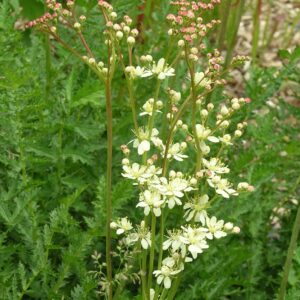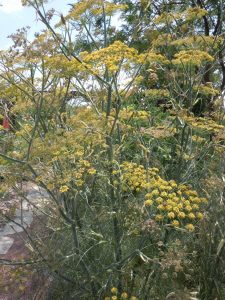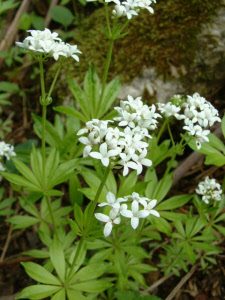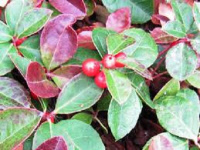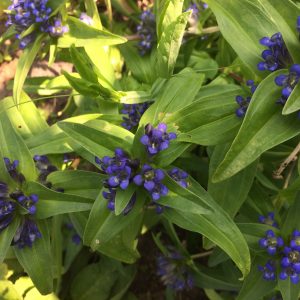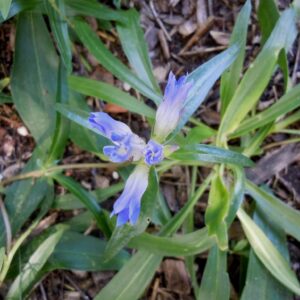Perennials & Biennials
Showing 193–200 of 511 results
-
Filipendula vulgaris syn. F. hexapetala Dropwort or Meadowsweet Z 3-9
In early summer bundles of milk white ball-shaped buds and open blossoms atop clumps of finely-cut, fern-like leaves, both flowers and foliage fragrant, early to mid-summer.
OUT OF STOCK
In early summer bundles of milk white ball-shaped buds and open blossoms atop clumps of finely-cut, fern-like leaves, both flowers and foliage fragrant, early to mid-summer.
Size: 24" x 18"
Care: sun in moist to moist well-drained soil
Native: Europe, north and central Asia
Wildlife Value: attracts bees, beetles and fliesFilipendula is Latin from filum meaning thread and pendulus meaning hanging for small tubers hanging by threadlike roots. In the 1600’s Nicholas Culpepper described Meadowsweet’s medicinal uses as curing bladder problems, throat, lung diseases and “the falling sickness.” Filipendula vulgaris also remedied bloated stomachs “dissolving and breaking the wind.”
-
Foeniculum vulgaris ‘Purpureum’ Bronze fennel Z 4-9
Yellow blooms on flat-topped umbels in late spring into summer, features dusky purple, feathery, compound, aromatic purple leaves with needle-like segments.
Yellow blooms on flat-topped umbels in late spring into summer, features dusky purple, feathery, compound, aromatic purple leaves with needle-like segments.
Size: 4-5’ x 2-3’
Care: sun to part shade in well-drained soil. Drought tolerant.
Native: Mediterranean
Wildlife Value: attracts bees and birds. Nectar plant for Swallowtail butterflies. Flat-topped surface gives insects a landing pad.Ancient Egyptians used fennel as food and medicine. Considered a snake bite remedy in ancient China. During the Middle Ages it was hung over doorways to drive away evil spirits. Fennel is also associated with the origin of the marathon. Athenian Pheidippides carried a fennel stalk on his 150-mile, 2-day run to Sparta to gather soldiers for the battle of Marathon with Persia in 490 B.C. The battle itself was also reportedly waged on a field of fennel. The Gardeners Dictionary, eighth ed. 1768.
-
Galium odoratum Sweet woodruff, Bedstraw Z 4-8
Whorls of fine textured leaves, like spokes of a wheel, with white blooms in spring lighting up the shade
Whorls of fine textured leaves, like spokes of a wheel, with white blooms in spring lighting up the shade
Size: 6-12" x 18" spreading
Care: shade to part shade in moist to moist well-drained soil.
Native: Europe and Mediterranean areaCalled “Bedstraw” because, according to legend, Mary rested on hay of Bedstraw on Christmas. May wine made an ancient herbal remedy: handful of dried and crushed leaves plus fresh lemon juice steeped in wine for 3-4 hours “makes a man merry and (is) good for the heart and liver.” Garlands hanging in houses in summer “coole and make fresh the place, to the delight and comfort of such as are therein.” per English herbalist Gerard, 1633. Dried branches give a grassy vanilla fragrance, used in sachets and potpourris, as an insect repellant and to make grey-green dyes.
-
Gaultheria procumbens Wintergreen, Checkerberry, Teaberry Z 3-8
“Gaultheria procumbens is in absolute perfection and beautiful – first as regards its bell-shaped blossoms, and afterwards its berries…” The Garden January 1876.
OUT OF STOCK
“Gaultheria procumbens is in absolute perfection and beautiful – first as regards its bell-shaped blossoms, and afterwards its berries…” The Garden , January 1876.
Size: 4” x 2’, spreading slowly - will make dense groundcover in time.
Care: part shade in moist to moist well-drained, acidic soil
Native: Eastern North America – Canada to Georgia west to Wisconsin
Awards: England’s Royal Horticultural Society Award of Merit.Ojibwa made tea from the leaves; the tea “makes them feel good.” Oneida used this for women having a painful menstrual cycle. For the Algonquin Wintergreen cured the common cold, headaches, grippe and stomachaches. Cherokee cured swollen gums and colds. Berries described as a grape in 1717. Named by Swedish botanist Peter Kalm after Dr. Gaulthier, with whom he botanized in Canada in 1749. Sold in America’s 1st plant catalog, Bartram’s Broadside, 1783. During the American Revolution when tea became unavailable, colonists used the plant to make tea. The tea reputedly relieved pain from headaches, muscle pains and colds. The leaves contain oil effective against pain – methyl salicylate. Pressed specimen in Emily Dickinson’s herbarium.
-
Gaura lindheimeri syn. Oenothera lindheimeri White gaura, Beeblossom Z 5-9
Multitudes of small white/pink. 4-petaled blossoms on wiry stems from May to October. Cut back by half in July to increase blossoms, as though the hoards are not enough.
OUT OF STOCK
Multitudes of small white/pink. 4-petaled blossoms on wiry stems from May to October. Cut back by half in July to increase blossoms, as though the hoards are not enough.
Size: 36” x 36”
Care: Full sun in well-drained to moist well-drained acidic soil
Native: Texas and Louisiana
Wildlife Value: deer & rabbit resistant. Source of pollen for bees, butterflies and hummingbirds
Awards: Royal Horticultural Society Award of Merit.Gaura is from the Greek gauros meaning superb. Collected in 1851 by German plant hunter Ferdinand Lindheimer (1801-1879) in the Texas Hill Country. Lindheimer considered the Father of Texas botany. L.H. Bailey (1913) wrote: “The best kind is Gaura lindheimeri which has white flowers of singular appearance, with rosy calyx tubes.”
-
Gentiana cruciata Cross-leaf gentian Z 4-9
Reputed the easiest Gentian, its true-blue clusters of short trumpet flowers grow from leaf axils of upper stems, from August through September. Lance-shaped, leathery leaves crowd below and cross one another as its name describes.
Reputed the easiest Gentian, its true-blue clusters of short trumpet flowers grow from leaf axils of upper stems, from August through September. Lance-shaped, leathery leaves crowd below and cross one another as its name describes.
Size: 8-16” x 12-16”
Care: sun to part shade in moist or moist well-drained soil.
Native: much of Europe and East Asia
Wildlife Value: Attracts hummingbirds, butterflies and other insects. Rabbit resistantIn mid-1700’s it was said to grow “. . .in Pannoniae, (province of the Roman Empire bounded on the north and east by the Danube) and Apenninorum, (probably about the Apennines Mountain range of Italy) and Helvetia.” (Switzerland). Linnaeus, Species Plantarum 1: 231. 1753. (1 May 1753) Known more than 600 years ago, possibly before. Leonard Fuchs, German doctor and botanist, (1501-1566) named and described it. Renamed to its current name by botanist Caspari Bauhin (1560-1625) in Pinax Theatricum
-
Gentiana dahurica Siberian Gentian da wu li qin jiao in China Z 4-7
Clusters of dark blue tubes with white throats blooming in mid to late summer – one of the easiest (least picky) gentians to grow. One botanist believes this is the same as Gentiana gracilipes. I admit, we’ve grown both and I cannot tell the difference. Botanists sometimes differentiae plants on tiny plant parts not readily visible. Such botanists are called “splitters.” We’ll await modern DNA testing to tell.
Clusters of dark blue tubes with white throats blooming in mid to late summer – one of the easiest (least picky) gentians to grow. One botanist believes this is the same as Gentiana gracilipes. I admit, we’ve grown both and I cannot tell the difference. Botanists sometimes differentiae plants on tiny plant parts not readily visible. Such botanists are called “splitters.” We’ll await modern DNA testing to tell.
Size: 6-12” x 12”
Care: sun to part shade in moist well-drained soil
Native: China & Mongolia, Russia.Gentian named after King Gentius of Illyria in the Adriatic. He discovered medicinal uses for gentians around 180 B.C. This species described in 1812.
-
Gentiana gracilipes Kansu gentian, Grass-leaved gentian Z 4-7
Clusters of trumpets of gentian blue flowers with five petals open at the apex on lax stems sprawl among its lance-shaped foliage. Blooms July – September. One botanist believes this is the same as Gentiana dahurica. I admit, we’ve grown both and I cannot tell the difference. Botanists sometimes differentiae plants on tiny plant parts not readily visible. Such botanists are called “splitters.” We’ll await modern DNA testing to tell.
OUT OF STOCK
Clusters of trumpets of gentian blue flowers with five petals open at the apex on lax stems sprawl among its lance-shaped foliage. Blooms July – September. One botanist believes this is the same as Gentiana dahurica. I admit, we’ve grown both and I cannot tell the difference. Botanists sometimes differentiae plants on tiny plant parts not readily visible. Such botanists are called “splitters.” We’ll await modern DNA testing to tell.
Size: 6-12” x 12-15”
Care: Sun to part shade in moist well-drained soil
Native: NW China
Wildlife Value: food for Bumble beesCollected by 1915.

